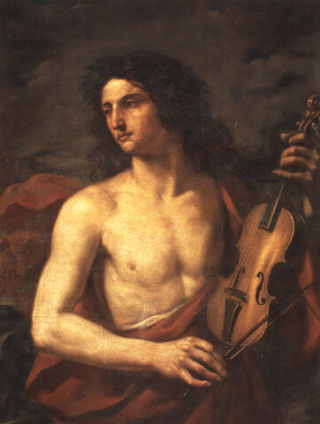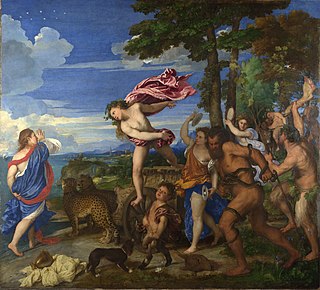Related Research Articles

Claudio Giovanni Antonio Monteverdi was an Italian composer, choirmaster and string player. A composer of both secular and sacred music, and a pioneer in the development of opera, he is considered a crucial transitional figure between the Renaissance and Baroque periods of music history.

Mantua is a city and comune in Lombardy, Italy, and capital of the province of the same name.

Federico II of Gonzaga was the ruler of the Italian city of Mantua from 1519 until his death. He was also Marquis of Montferrat from 1536.
Giaches de Wert was a Franco-Flemish composer of the late Renaissance, active in Italy. Intimately connected with the progressive musical center of Ferrara, he was one of the leaders in developing the style of the late Renaissance madrigal. He was one of the most influential of late sixteenth-century madrigal composers, particularly on Claudio Monteverdi, and his later music was formative on the development of music of the early Baroque era.
The year 1607 in music involved some significant events.

L'Orfeo, sometimes called La favola d'Orfeo, is a late Renaissance/early Baroque favola in musica, or opera, by Claudio Monteverdi, with a libretto by Alessandro Striggio. It is based on the Greek legend of Orpheus, and tells the story of his descent to Hades and his fruitless attempt to bring his dead bride Eurydice back to the living world. It was written in 1607 for a court performance during the annual Carnival at Mantua. While Jacopo Peri's Dafne is generally recognised as the first work in the opera genre, and the earliest surviving opera is Peri's Euridice, L'Orfeo is the earliest that is still regularly performed.

The Duchy of Mantua was a duchy in Lombardy, northern Italy. Its first duke was Federico II Gonzaga, member of the House of Gonzaga that ruled Mantua since 1328. The following year, the Duchy also acquired the March of Montferrat, thanks to the marriage between Gonzaga and Margaret Paleologa, Marchioness of Montferrat.

Vincenzo Ι Gonzaga was the ruler of the Duchy of Mantua and the Duchy of Montferrat from 1587 to 1612.

Guglielmo Gonzaga was Duke of Mantua from 1550 to 1587, and of Montferrat from 1574 to 1587. He was the second son of Federico II Gonzaga, Duke of Mantua and Margaret Palaeologina of Montferrat. In 1574, Montferrat was elevated to a Duchy and Guglielmo became its first duke. He was succeeded as Duke of both duchies by his son Vincenzo.

The Palazzo Ducale di Mantova is a group of buildings in Mantua, Lombardy, northern Italy, built between the 14th and the 17th century mainly by the noble family of Gonzaga as their royal residence in the capital of their Duchy. The buildings are connected by corridors and galleries and are enriched by inner courts and wide gardens. The complex includes some 500 rooms and occupies an area of c. 34,000 m2, which make it the sixth largest palace in Europe after the palaces of the Vatican, the Louvre Palace, the Palace of Versailles, the Royal Palace of Caserta and the Castle of Fontainebleau. It has more than 500 rooms and contains seven gardens and eight courtyards. Although most famous for Mantegna's frescos in the Camera degli Sposi, they have many other very significant architectural and painted elements.
Francesco Rasi was an Italian composer, singer (tenor), chitarrone player, and poet.

L'Arianna is the lost second opera by Italian composer Claudio Monteverdi. One of the earliest operas in general, it was composed in 1607–1608 and first performed on 28 May 1608, as part of the musical festivities for a royal wedding at the court of Duke Vincenzo Gonzaga in Mantua. All the music is lost apart from the extended recitative known as "Lamento d'Arianna". The libretto, which survives complete, was written in eight scenes by Ottavio Rinuccini, who used Ovid's Heroides and other classical sources to relate the story of Ariadne's abandonment by Theseus on the island of Naxos and her subsequent elevation as bride to the god Bacchus.
Benedetto Pallavicino was an Italian composer and organist of the late Renaissance. A prolific composer of madrigals, he was resident at the Gonzaga court of Mantua in the 1590s, where he was a close associate of Giaches de Wert, and a rival of his younger contemporary Claudio Monteverdi.
Il ballo delle ingrate is a semi-dramatic ballet by the Italian composer Claudio Monteverdi set to a libretto by Ottavio Rinuccini. It was first performed in Mantua on Wednesday, 4 June 1608 as part of the wedding celebrations for Francesco Gonzaga and Margaret of Savoy. Both Vincenzo and Francesco Gonzaga took part in the dancing. Monteverdi also composed the opera L'Arianna and the music for the prologue to Guarini's play L'idropica for the occasion.
These lists show the audio and visual recordings of the opera L'Orfeo by Claudio Monteverdi. The opera was first performed in Mantua in 1607, at the court of Duke Vincenzo Gonzaga, and is one of the earliest of all operas. The first recording of L'Orfeo was issued in 1939, a freely adapted version of Monteverdi's music edited by Giacomo Benvenuti, given by the orchestra of La Scala Milan conducted by Ferrucio Calusio. In 1949 the Berlin Radio Orchestra under Helmut Koch recorded the complete opera, on long-playing records (LPs). The advent of LP recordings was, as Harold Schonberg later wrote, an important factor in the postwar revival of interest in Renaissance and Baroque music, and from the mid-1950s recordings of L'Orfeo have been issued on many labels. Koch's landmark version was reissued in 1962, when it was compared unfavourably with others that had by then been issued. The 1969 recording by Nicholas Harnoncourt and the Vienna Concentus Musicus, using Harnoncourt's edition based on period instruments, was praised for "making Monteverdi's music sound something like the way he imagined". In 1981 Siegfried Heinrich, with the Early Music Studio of the Hesse Chamber Orchestra, recorded a version which re-created the original Striggio libretto ending, adding music from Monteverdi's 1616 ballet Tirsi e Clori for the Bacchante scenes. Among more recent recordings, that of Emmanuelle Haïm has been praised for its dramatic effect. The 21st century has seen the issue of an increasing number of recordings on DVD.
Giovanni Gualberto Magli was an Italian castrato who had an active singing career during the first quarter of the 17th century. Born in Florence, he studied voice with Giulio Caccini before becoming a musician for the House of Medici on 23 August 1604. He participated in the world premiere of Claudio Monteverdi's L'Orfeo in 1607 at the court of Prince Francesco IV Gonzaga, Duke of Mantua, portraying the roles of La Musica and Proserpina and possibly one other part. The musicologist and historian Hans Redlich mistakenly allocates Magli to the role of Orfeo. In 1608 he sang for the wedding festivities of Cosimo II de' Medici, Grand Duke of Tuscany and Archduchess Maria Maddalena of Austria. In October 1611 he was granted two years paid leave by Antonio de' Medici to pursue further studies in Naples. He left Medici service in 1615 to join the musicians at the court of John Sigismund, Elector of Brandenburg. He remained there until September 1622. He was buried in Florence on 8 January 1625.

The Italian composer Claudio Monteverdi (1567–1643), in addition to a large output of church music and madrigals, wrote prolifically for the stage. His theatrical works were written between 1604 and 1643 and included operas, of which three—L'Orfeo (1607), Il ritorno d'Ulisse in patria (1640) and L'incoronazione di Poppea (1643)—have survived with their music and librettos intact. In the case of the other seven operas, the music has disappeared almost entirely, although some of the librettos exist. The loss of these works, written during a critical period of early opera history, has been much regretted by commentators and musicologists.
References
- ↑ Thomas Forrest Kelly (2000). First Nights: Five Musical Premieres. Yale University Press. ISBN 0300091052.
- 1 2 3 Iain Fenlon (1980). Music and patronage in sixteenth-century Mantua, Volume 2, pg 28. CUP Archive. ISBN 9780521229050.
- ↑ Fenlon, "The Mantuan Orfeo" pp. 1–4
- ↑ Sternfeld, p. 26
- ↑ Tim Carter (2002). Monteverdi's musical theatre. Yale University Press. ISBN 0300096763.